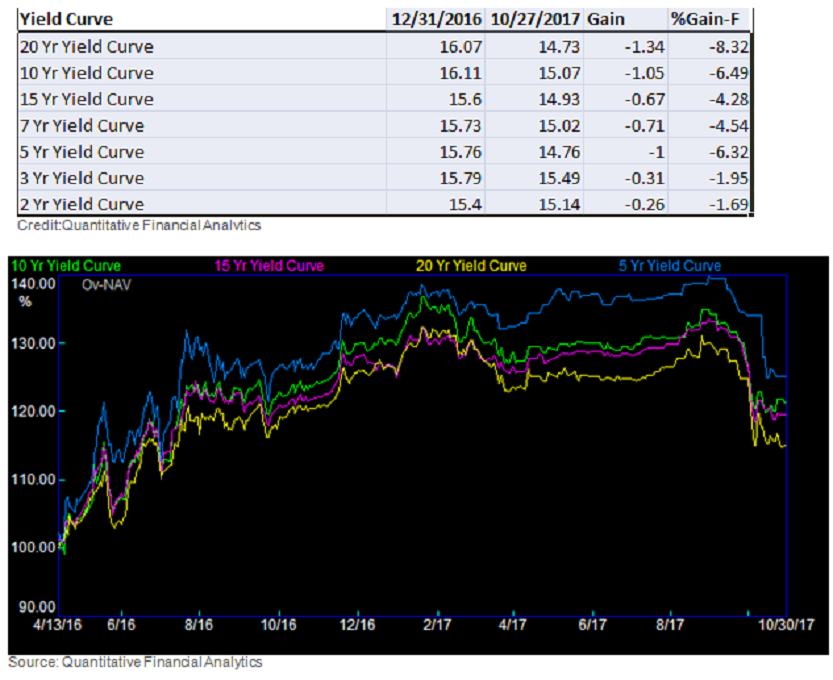Economy
Nigeria’s Falling Yield Could Lead to Shift in Investment Strategy

By Quantitative Financial Analytics
Traditionally, investors’ appetite and need for income comes from fixed income instruments like treasury bills and bonds.
Until recently, 10-year Nigeria treasuries have delivered an average yield in the upwards of 15 percent thereby providing a high level of income to investors with a relatively minimal level of risk.
However, current economic events are giving rise to low interest rates. Yield curves have been falling across all tenors. The 10-year yield fell by 6 percent between January and October while the 20-year yield decreased by 8 percent to 15.07 percent and 14.74 percent respectively.
Granting that yields move in the opposite direction of prices, this trend implies that the prices of fixed income instruments are trending upwards indicating that people are buying more and more of FGN and other bonds.
This also implies that the government may be able to issue T-Bills or refinance maturing bonds at cheaper rates.
One effect of the decreasing yield is that it is creating a gap between investors’ income needs and the income usually provided by traditional fixed income investments.
With bond yields trending low these days, investors could be forced to change their investment strategy away from traditional fixed income instruments to high yield dividend stocks. The advantage of such strategy change is that such strategies can deliver both the high yields required to meet their current income needs as well as the opportunities to grow their principal.
Unfortunately, the Nigerian market does not boast of a sizable number of high dividend yield stocks.
Currently, only 3 stocks have dividend yields that are better than what traditional fixed income instruments provide. While Smart Products Nigeria Plc and RAK Unity Pet company have dividend yield of 42 percent and 20 percent respectively, United Capital Plc and Zenith International Bank Plc have 16.29 percent and 14.7 percent respectively.
The seeming dearth in the existence of high dividend yield stocks could be as a result of the increase in stock prices in recent months. The relationship between stock prices and dividend yield is such that as stock prices increase, dividend yield decreases.
That notwithstanding, those with keen eyes on the market may be able to uncover the stocks that could bridge the income gap being created by the falling trend in yields.

Economy
APM Terminals Apapa Records 31.5% Surge in Exports in April

By Adedapo Adesanya
APM Terminals Apapa has reported a 31.5 per cent increase in export volumes for April 2025, reaching its highest monthly figure since operations began in 2006.
The terminal handled 8,687 twenty-foot equivalent units (TEUs) of export cargo, up from 6,606 TEUs in April 2024.
According to the terminal manager, Mr Steen Knudsen, this underscores a major milestone in Nigeria’s growing export momentum and reflects years of sustained growth and strategic investment in export infrastructure.
“It’s advantageous for Nigerian shippers when ships depart our ports fully loaded with exports. Preventing ships from leaving empty positively influences the overall cost of shipments into Nigeria,” he said.
Mr Knudsen attributed the growth to targeted operational improvements and alignment with national economic priorities.
“Our aim aligns with the Federal Government’s vision of transforming Nigeria into an export-driven economy. To support this, we launched a new rail service in February to expedite the movement of goods from the hinterland to Apapa port,” he revealed.
“We’ve expanded our yard capacity for exports and introduced dedicated truck lanes to streamline the process, reducing the time exports spend in the terminal and ensuring timely ship departures,” he added.
Mr Knudsen praised top agencies including Nigerian Ports Authority (NPA) and Nigerian Railway Corporation (NRC) for their support in enabling the terminal to focus on delivering top-tier services to its customers.
Since acquiring the Apapa concession, the company has made significant capital investments to boost capacity, efficiency, and overall terminal productivity.
In the last four years, APM Terminals Apapa has recorded a steady rise in export volumes. In 2022, the terminal handled 53,807 TEUs of exports. This number rose to 70,432 TEUs in 2023 and 77,631 TEUs in 2024.
As Nigeria’s largest container terminal and a subsidiary of the A.P. Moller Maersk Group, APM Terminals Apapa continues to play a central role in the modernization and expansion of the country’s maritime logistics network.
Economy
Tinubu’s Aide on Entrepreneurship Development Lauds Legend Internet NGX Listing

By Aduragbemi Omiyale
President Bola Tinubu’s Senior Special Assistant on Entrepreneurship Development in Communications, Innovation and Digital Economy, Ms. Chalya Shagaya, has commended Legend Internet Plc for listing its shares on the Nigerian Exchange (NGX) Limited.
Last month, the internet service provider (ISP) listed about two billion stocks valued at N12.4 billion on the local bourse, becoming the first indefinite telecom operator in Nigeria to do so, reflects strong investor confidence in nation’s digital economy.
Speaking during a visit to the headquarters of the organisation, Ms Shagaya praised the team led by Mr Bruce Ayonote for the achievement.
“The listing of Legend Internet Plc is not just a corporate achievement, it is a national win. It sends a powerful message to indigenous digital and tech companies that the capital markets are within reach,” Ms Shagaya stated.
The President’s aide further highlighted the alignment of this success with the Renewed Hope Agenda of her boss, emphasising the administration’s dedication to building a business-friendly environment driven by digital transformation and inclusive economic growth.
She also applauded the tech firm for its inclusivity efforts, noting that the majority of its executive and senior members of staff are women, describing this as a progressive example of gender representation in leadership, which aligns with national goals for women’s inclusion in economic development.
Ms Shagaya expressed her readiness to support Legend Internet and its affiliate company, Suburban, in future initiatives, including expansion of digital infrastructure, innovation policy development, and capacity building programs for entrepreneurs.
She also stressed the ripple effect such achievements could have on the broader ecosystem, from enhancing local content development and broadband access to creating jobs and fostering innovation, encouraging the organisation to further engage in mentorship, tech training, and entrepreneurship support initiatives.
“Legend Internet’s story is one of vision, resilience, leadership, and inclusivity. It is the kind of story this administration is proud to champion and we look forward to partnering with more companies that are pushing the boundaries of what is possible,” she stated.
Economy
NASD Bourse Soars 0.64% to N1.947trn

By Adedapo Adesanya
The NASD Over-the-Counter (OTC) Securities Exchange recorded a 0.64 per cent increase on Monday, May 12, with its total value rising by N12.46 billion to N1.947 trillion from the N1.935 trillion quoted at the preceding session, as the NASD Unlisted Security Index (NSI) went up by 21.28 points to 3,326.06 points from 3,3204.74 points.
The expansion recorded during the first trading session of the week was influenced by price appreciation in the shares of three companies admitted to the platform.
Central Securities Clearing System (CSCS) went up by N2.25 to trade at N24.85 per unit versus last Friday’s N22.60 per unit, FrieslandCampina Wamco Nigeria Plc improved its value by 40 Kobo to settle at N40.43 per share from the previous closing value of N40.03, per share, and Geo-Fluids Plc added 10 Kobo to end at N1.91 per unit, on contrast to the preceding session’s N1.81 per unit.
During the trading day, the volume of shares bought and sold by the market participants decreased by 99.7 per cent to 673,233 units from the 231.6 million units traded in the previous trading day, the value of securities transacted by investors moderated by 98.9 per cent to N6.3 million from N606.4 million, and the number of deals retreated by 38.6 per cent to 35 deals from 57 deals.
When trading activities finished for the day, the most active stock by volume on a year-to-date basis remained Impresit Bakolori Plc with a turnover of 534.0 million units worth N521.1 million, followed by Geo-Fluids Plc with 266.4 million units valued at N470.5 million, and Okitipupa Plc with 153.6 million units sold for N4.9 billion.
The most traded stock by value on a year-to-date basis also remained Okitipupa Plc with the sale of 153.6 million units for N4.9 billion, trailed by FrieslandCampina Wamco Nigeria Plc with 20.0 million units valued at N768.5 million, and Impresit Bakolori Plc with a turnover of 534.0 million units worth N521.1 million.
-

 Feature/OPED5 years ago
Feature/OPED5 years agoDavos was Different this year
-
Travel/Tourism9 years ago
Lagos Seals Western Lodge Hotel In Ikorodu
-

 Showbiz2 years ago
Showbiz2 years agoEstranged Lover Releases Videos of Empress Njamah Bathing
-

 Banking7 years ago
Banking7 years agoSort Codes of GTBank Branches in Nigeria
-

 Economy2 years ago
Economy2 years agoSubsidy Removal: CNG at N130 Per Litre Cheaper Than Petrol—IPMAN
-

 Banking2 years ago
Banking2 years agoFirst Bank Announces Planned Downtime
-

 Sports2 years ago
Sports2 years agoHighest Paid Nigerian Footballer – How Much Do Nigerian Footballers Earn
-

 Technology4 years ago
Technology4 years agoHow To Link Your MTN, Airtel, Glo, 9mobile Lines to NIN













